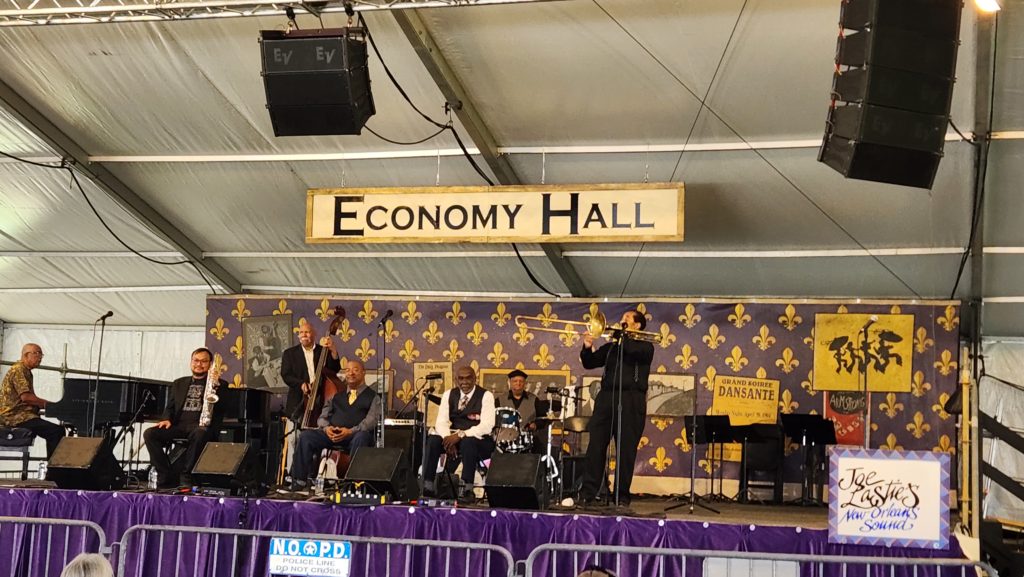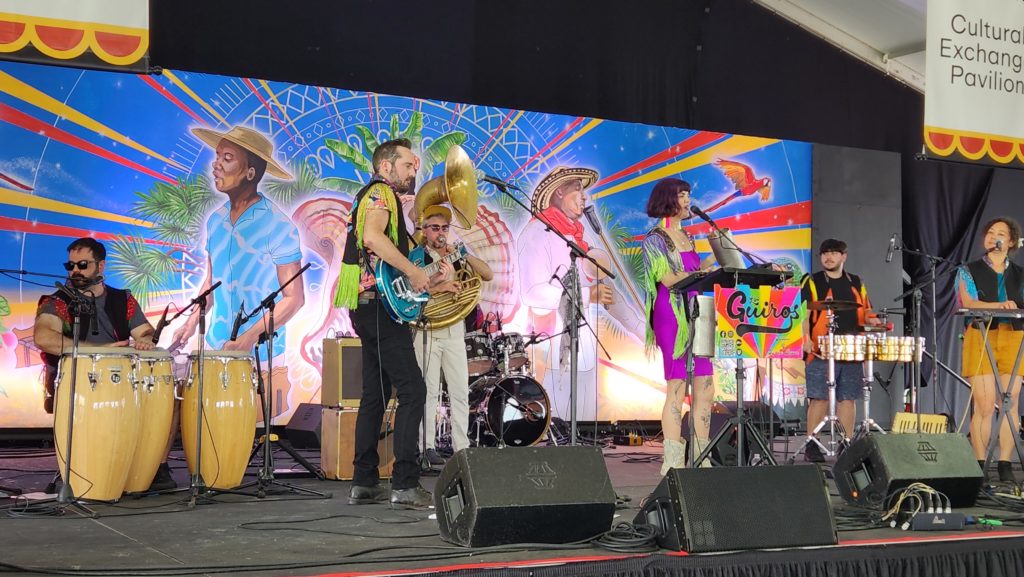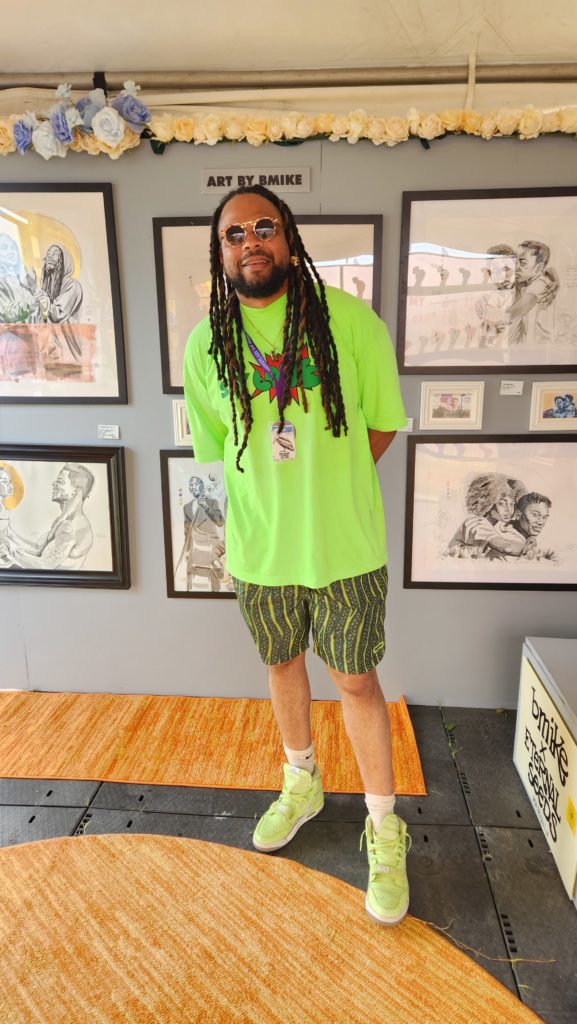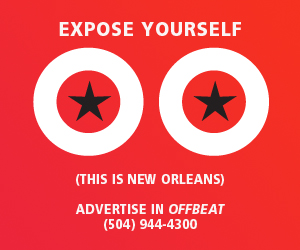The long-awaited Rolling Stones performance on Jazz Fest Day 5 did not disappoint.
The Rolling Stones
It used to be an expected thing that the big-name headliners who played Jazz Fest would musically honor the occasion instead of just doing their usual arena set. Cheers then to the Rolling Stones for reviving that tradition: their set was steeped in New Orleans, including a pointed political reference. “We’re an inclusive group, we include everybody,” Mick Jagger noted. “And I believe Governor Landry is here, so we include him—even if he wants to take us back to the Stone Age.” [Landry felt compelled to respond to Jagger’s remark: “You can’t always get what you want. The only person who might remember the Stone Age is #MickJagger. Love you buddy, you’re always welcome in Louisiana. #LoveMyCountryMusic.”]
They brought Dwayne Dopsie onstage to add accordion to a rarely played track, “Let It Bleed.” But the big moment was their performance of “Time Is On My Side” with Irma Thomas, who’d spilled the beans about it on social media beforehand. The Stones famously caused hurt to Thomas by copying her arrangement of the tune and having the international hit with it. But on the Fair Grounds, Jagger played proper respect to her in the intro: “We heard a record we really loved, and it became our first U.S. hit. And the artist who did the song was the Soul Queen of New Orleans.” They performed the tune by singing it directly at each other, with Thomas singing the “You’ll come running back” part and Jagger doing the ad-libs. He looked properly respectful, and she looked fully charmed. Call those fences mended.
Credit also goes to new backup singer Chanel Haynes, a New Orleans native who took Merry Clayton’s part on “Gimme Shelter” and “Lady Gaga’s” on “Sweet Sounds of Heaven.” She was positively chilling on the former. The second tune, a gospel number from the Stones’ new album Hackney Diamonds, may well go down in history as the last great Stones song: it’s one of the few that goes out of its way to be inspirational, and its presence in the encore elevated the show another notch. No matter how many Stones shows you’ve seen, you hadn’t seen this one.
Dumpstaphunk
Few things are sadder than the passing of a beloved musician during Jazz Fest season, and Dumpstaphunk was shaken by the loss of bassist Nick Daniels on April 26. Their pre-Stones set was the band’s first since then (though most of them backed an Ivan Neville solo show at Lafayette Park the previous night), and Neville took time out to say that “From this day forward, everything we do is going to be in honor of Nick Daniels III.” There followed a particularly moving performance of Daniels’ song “Make It After All,” where Daniels’ upbeat spirit came through loud and clear.
Darcy Malone
Darcy Malone proved her mettle as one of the city’s more powerful young vocalists during her early set with the Tangle. The set was capped by a tribute to one of her own heroines, Leigh “Little Queenie” Harris: she played not only Queenie’s classic tune “My Darlin’ New Orleans” but that single’s flipside, “Wild Natives.” Queenie would have likely approved of her intense soul ballad “Bleed Me Dry” and the playful sexiness she brought to Randy Newman’s “You Can Leave Your Hat On.”
—Brett Milano
The Rolling Stones Thursday impacted everything around it at Jazz Fest, as befitting the most enduring and arguably the most legendary rock band in the world, still recording and touring after 60 years. Here’s the interesting thing, though. This is indeed the Jazz & Heritage Festival. Louisiana regional heritage not only shone, it was the key element in lifting an already-striking Stones set even higher.
Joe Lastie
In the morning, the line was at least two blocks deep at the Gentilly entrance by 10:30 a.m. as most were waiting for a mad dash to get the best spot for the Stones set at 5 p.m. The doors opened a bit early, which allowed time to enjoy a Turducken Po-boy from Crescent Catering and take my sweet time over to Economy Hall to catch Joe Lastie.
Drummer Lastie is the definition of heritage and tradition, and it’s a guarantee his band will also include savvy veterans. Don’t forget dapper too. When the band is this strong, everyone gets a turn soloing, from trombonist Freddie Lonzo to trumpet player Gregg Stafford; from clarinetist Louis Ford to stand-up bassist Richard Moten; and from saxophonist Dr. Pat to pianist Rickie Monie. Their lovely version of “Just A Closer Walk With Thee,” which Lastie introduced with, “We played this every week at church,” started the day and week two off right.
Ariee & The AMG Band
Next up was Ariee & The AMG Band at the Congo Square Stage. New Orleans doesn’t tend to be a city with much pop music and Ariee was ready to do her thing with originals and a strong band, including a DJ. From “Glow” to “Eye on You,” she showed she’s one to watch in both the city and on a national stage.
The Cultural Exchange Pavilion (and surrounding stages) this week features Batambora and Enkele, two groups from Colombia well worth your time. Right nearby, along with ceviche and empanadas, you will find the drink that’s been a hit, the Cocoloco. Get it regular or frozen.
On the way over to the Festival Stage, it was great to see “The Ya-Ka-Mein Lady” Ms. Linda Green with her food booth in perfect position next to the Jazz & Heritage Stage. Grammy-nominated New Breed Brass Band held court with Trombone Shorty. New Breed is a group of young guys, sharp, on point, and with Caribbean and other influences. “Treme Island” from their debut album was particularly churning, burning, and thrilling the Festival Stage crowd at that point already was filling up most of the lawn.
Samantha Fish
Keeping at the same stage, Samantha Fish was all business, with little chit chat in between songs. Let’s be clear: Samantha Fish rocks. Whether on cigar box guitar or Strat, she brought it. Fish used every minute of her set to wow the crowd with all-out rockers and slow burn songs with big vocals. “Better Be Lonely” particularly hit all the way to the back of the lawn, which was packed well before the end of her show.
Los Guiros
Los Guiros did double duty Thursday at both the Cultural Exchange Pavilion and Jazz & Heritage Stage, which worked perfectly for frontwoman Corina Hernandez to lead a boisterous band who plays psychedelic cumbias, with a New Orleans twist—Todd Burdick on the tuba. Los Guiros’ set included Colombian and Peruvian covers as well as their own “Cumbia Mezcal,” featuring Shaye Cohn on synth.
You will find Brandan “Bmike” Odums and Eternal Seeds tucked in the Bruce Brice Art Village, where they’ve been for the past two years on the way to the Gentilly Stage. While Bmike has become an internationally acclaimed in-demand artist, it’s only strengthened his resolve to have something to say and do it the right way. He stressed, “For us, when we had the opportunity to have this tent, what is the theme to create around it? We want this to be exploratory, participatory, and not just feel like a marketplace. Everyone who walks around Jazz Fest would say they love New Orleans music. Our counter is, ‘How deep is your love? Do you know what it means to really love New Orleans? Challenging that as far as sustainability of the culture and having a future for this place that we love.” Written on a funhouse mirror outside the tent is a sobering fact from The Data Center that deepens the conversation, “Say love, the average New Orleans musician earns $29k a year.”
Bmike’s been at Jazz Fest in other forms and fashions previously, and you will recall his striking 2017 Congo Square poster featuring Jon Batiste. As it turns out, the New Orleans music tradition also has a key influence in the formation of Eternal Seeds, BMike’s non-profit to work with the next generation of artists. He explained, “Some of my contemporaries like Trombone Shorty, Jon Batiste, Christian Scott, Khris Royal—as a visual arts student at NOCCA, I would look at them and be kind of jealous of the organic apprentice process that they had. For me, it was synthesizing for artists in the same way. This tent wasn’t just built by me. The high school students had a part in it too, some of them here at Jazz Fest for the first time.”
Dumpstaphunk, led by Ivan Neville, may have had a crowd sprawling from the Crawfish Monica booth to the beginnings of filling up the sandy infield, but that couldn’t have made heavy hearts any lighter at the recent passing of Nick Daniels III. “Where do we go from here?” took on extra significance, as did bassist Tony Hall doing a stunning version of the Daniels song, “Make It After All.” Dumpstaphunk is a band as impeccable as it gets, seeming constructed ideally for festival crowds.
While the infield became elbow-to-elbow and dark clouds rolled in, it was time to have a classic Vaucresson Sausage po boy. Turns out I learned a major fact along with it, as deep New Orleans history and heritage as it gets. Vance Vaucresson explained, “We’re the only original food vendor left. When George Wein came back from Newport News, my daddy, Robert ‘Sonny’ Vaucresson, had a restaurant at 624 Bourbon called Vaucresson’s Café Creole with his business partner Larry Borenstein. Larry and George were very good friends. One day they came to the café with a tuba player named Allen Jaffe who was helping to manage Preservation Hall. The conversation came about—how come the birthplace of jazz doesn’t have a festival? The brainstorming led to bringing this together. My dad was always there. The festival is the same age as me. I’ve grown up out here.”
It was a first for Jazz Fest that shortly before The Rolling Stones began at the Festival Stage, there were no other acts booked throughout the Fairgrounds. The Jumbotrons for spillover crowd all shifted to the Congo Square Stage, making for a nice picnic type vibe. The only question was, ‘Would it start pouring?’ There was no drawn-out intro for the Stones, only a short and sweet welcome kicked off accordingly with “Start Me Up” whose riff has been recognizable since 1981.
That was one of the most stunning takeaways of the two-hour Stones set almost entirely made up of hits spanning several decades. Across the board, the legendary songs themselves such as “Get Off Of My Cloud,” “Honky Tonk Women,” and “Jumpin’ Jack Flash” were immediately identifiable from the first second or so whether by guitar riff, cowbell or guiro. Iconic frontman Mick Jagger, who notably had a clothing rack on stage for costume changes, seemed as struck by the heat as he was with Louisiana’s governor.
Guitarist Keith Richards—he of the classic riffs—looked to be having the time of his life with guitars that had serious mileage on them. “Pleasure to be back. Pleasure to be anywhere,” he said wryly. Ronnie Wood’s electric sitar riff to “Paint It Black” was a pleasure in its own right. The two-guitar interaction of Richards and Woods made especially clear how they created the blueprint for blues-rock groups such as Aerosmith and Guns N’ Roses. Veteran drummer Steve Jordan held it down with authority. It was also great to see Karl Denson on sax and acknowledged by Jagger along with the entire band, as well as openers Dumpstaphunk and Samantha Fish.
There was no question the hits would hit, as did “Angry” off of the most recent Hackney Diamonds album. It was equally clear that the tried-and-true songs especially elevated at three key points when New Orleanians Irma Thomas and Chanel Haynes, and Lafayette’s Dwayne Dopsie hit the stage.
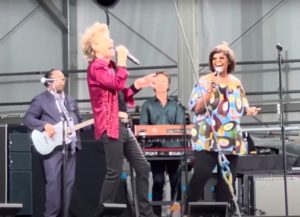
The Rolling Stones with Irma Thomas. Photo from You Tube.
The idea of an Irma Thomas duet with Mick Jagger struck everyone silly hours in advance. Not everyone realizes the back story, though, which I covered seven years back in OffBeat—“Time is on My Side” was originally Ms. Irma’s hit in 1964. She went on tour, including the U.K., and a couple young men (Mick and Keith) who had heard the song on the radio asked for her blessing to do their version of it. She didn’t know that their first U.S. tour had bombed and certainly didn’t expect that her song would be what would catapult the next tour and their career to superstardom. After that, she couldn’t sing the song without people asking why she was doing a Stones cover. This led to her not singing “Time is on My Side” until encouraged to bring it back by Bonnie Raitt in 1992. Side note—she didn’t write it, so no royalties.
When Mick announced her as “The lady who sang it first is The Soul Queen of New Orleans, Irma Thomas,” and they went on to do a lovely duet that will now be a forever highlight of Jazz Fest, it had special significance. Interestingly, Jagger commented that they hadn’t seen each other in 60 years.
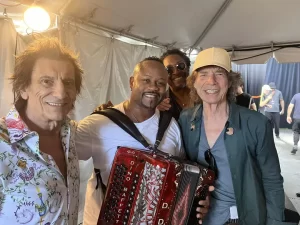
Ronnie Wood, Dwayne Dopsie and Mick Jagger, rehearsal. Photo from Dwayne Dopsie Facebook
Just prior to that, Zydeco Hellraiser Dwayne Dopsie hit the stage to transform “Let It Bleed” into a South Louisiana rootsy song. Jagger donned an acoustic guitar and Keith Richards stopped playing to clap after Dopsie’s accordion solo. This showed a beautiful elasticity to the song and made at least this attendee wish they had transformed the entire set this way to create unique musical bliss.
New Orleanian Merry Clayton’s background vocals in 1969s “Gimme Shelter” are considered by many the finest in rock music. It was ideal then for Stones background singer and New Orleans-own Chanel Haynes to not only be the lady on the mic but also stroll with power up to center stage and let loose. Her powerhouse performance on the song and interacting with Jagger up through the end of the song brought the house down two thirds into the set—even more so than the encore ending with “(I Can’t Get No) Satisfaction,” a crowd sing-long to beat all sing-alongs. The rain held off too, other than misting even lighter than the WWOZ Jazz Tent.
—Michael Allen Zell

